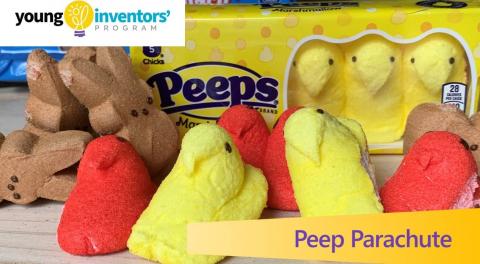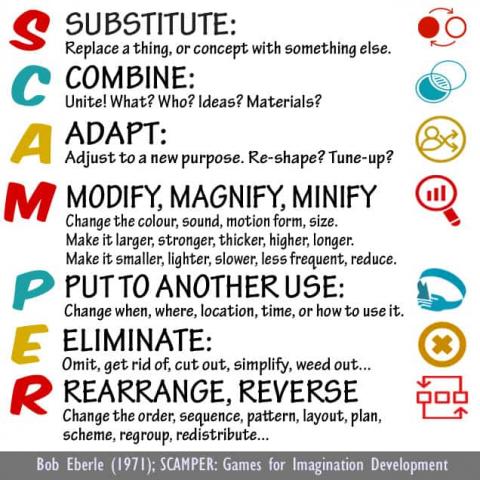Remote Learning for Young Inventors
We want to help you keep inventing no matter where you are learning!
Our YIP@HOME activities provide short videos with our staff and our inventive friends to walk you through a piece of our Young Inventors’ Program that lets you invent and learn a bit about STEM too!
Invent with us at home!
All activities are designed to use everyday materials and to be completed with little adult assistance. Each activity provides an introduction to a STEAM related topic, detailed instructions, explanations of the science involved, and ideas for further exploration for K-6 readers and inventors.
Once you complete an activity, share your design, creativity, and/or what you learned along the way. You can email us or tag us on social media at: @fuelthespark.

Engineer a Peep Parachute
This YIP@HOME Challenge is all about testing and playing around with things that don’t work. It’s also about realizing that an experiment that doesn’t work the way you thought it would isn’t really a failure. For this activity, you will test and re-test your engineering and design skills as you design a parachute to carry a light-weight object slowly to the ground. For our object, we use a Peep (large marshmallow treat), but you can use any light-weight object from home (cotton balls, small empty plastic container, Lego figure). See below for more details about materials.
The E in STEM
We all hear about engineers and know that the E in STEAM stands for Engineering, but what is engineering exactly?
Well, it’s a pretty broad subject area, but basically it is designing and building anything- from bridges to towers to simple machines and robots. Engineers tackle all sorts of challenges to come up with solutions for natural and man-made problems.
Fail Forward
One of the most important processes that Engineers do as they create their inventions or solutions is test. Engineers have to go through lots of testing before they have their final product. It is common for a first version of a design not to work, and even the second or the third. Engineers play with their designs and may change the size, weight, materials used or other parts of their models as they make their inventions.
For example, did you know that Thomas Edison tried many times to get his lightbulb to work before he came up with a successful one. When asked by a reporter about how it felt to fail so many times, Edison replied: “I have not failed. I have just found 10,000 ways that won’t work”.
Edison’s biggest hurdle was finding a filament that was strong, affordable, and would not burn out quickly. He and his team tested more than 6,000 materials before finding the one that worked: carbonized bamboo. Thomas Edison’s positive attitude and perseverance are model qualities that engineers must have to be successful inventors. Learn more about Edison in this StoryBots video on YouTube.
Watch the Peep Parachute Challenge
What You Need
A parachute is something that is made of light weight fabric, shaped kind of like an umbrella that can help people safely jump from an airplane. Due to air resistance, a drag force (the air pushes up on the fabric as it falls, like filling a balloon, to slow down its motion to the ground. The larger the parachute, the greater the resistance and the slower the object it holds will fall.
For the Peep Parachute Challenge, you can use all sorts of materials you find around the house. And because you are going to test and re-test and make several versions of your parachute to see which is most successful, you will want to try a variety of materials and play with shapes and sizes for the parachute.
What to Do
Design and test different versions of a parachute that will make a light-weight object fall to the ground as slowly and with the softest landing possible. You can use all sorts of materials and play around with their size and shape to see what makes the best parachute. Then attach the parachute designs to your object using string and tape (yarn, dental floss, ribbon, also work well) and find a spot above the ground (about 4 feet works well) to drop your parachute and object. Check with an adult to be sure your drop location is safe before you start.
Now test- try each design several times to observe. If you want, measure your exact distance from the ground and use a stopwatch to record the time it takes to for your parachute to land and write down the results. It may be helpful to have someone at home help you with this step.
See which design works best. Take photos and then submit them to us to complete the Challenge.
Testing Constants (The Things that Don’t Change)
The one constant (the thing that does not change in each test) is the object falling to the ground- in our example, the Peep. The goal is to design a parachute that makes your Peep (or object) fall the slowest.
Another constant that will be important in your testing is the drop location, each test should drop the parachute from the same spot so that the Peep travels the exact same distance to the ground every time so you know which design makes the Peep fall the slowest for the softest landing.
Suggested Materials:
- Objects to Drop: Peeps, large marshmallows, cotton balls, Lego figures, empty plastic container like a yogurt container or plastic egg (the object must be light-weight!)
- Parachute materials: fabric, paper, tissue paper, plastic bag, coffee filter
- String
- Tape
- Scissors
- Pencil or pen to take notes and draw designs
- Paper or notebook to take notes and draw designs
- Stopwatch or clock (optional if you wish to time your drops)
- Measuring tape (optional if you wish to record the distance of your drops)
Lesson Plan
Our lesson plan outlines this activity, materials, and script to follow to lead the challenge. It’s for everony, teachers, parents, leaders, and students, here is the full lesson plan to follow.
Showcase Your Peep Parachute
We can’t wait to see your awesome ideas! Take a photo, video, or scan and upload a picture of your design. Email it to us, or send your photo, video or uploaded picture or design to your teacher at school to submit to us. You can also tag us on Instagram: @FueltheSpark.
Did You Love this Activity?
If you loved this activity and want to support more, please make a gift to the Academy to help us develop more YIP@HOME and STEM programming.

How do you brainstorm new ideas?
Learn how inventors come up with new ideas using the S.C.A.M.P.E.R. brainstorming technique. Each letter stands for a way to rethink or think up ideas for your design.
Watch Tina White, Director of the Young Inventors’ Program and her friend Thomas use S.C.A.M.P.E.R. to design cool kitchen tools.
Resources
Our Cool Kitchen Tool Lesson Plan includes steps to design cool kitchen tools and the S.C.A.M.P.E.R. list ready to print.
Materials
Materials you need for this challenge: PLEASE ask an adult for permission to use an existing kitchen tool for your design:
- Paper or notebook for taking notes
- Pen or pencil
- Kitchen utensil (ask an adult)- spatula, wooden spoon, colander, measuring cup, etc.
- Markers, colored pencils or crayons
Share Your Design
Take a photo, or scan and upload a picture of your drawing or design. To share your design with us:
- Email your teacher, or
- Email us, or
- Share on Instagram and tag us: @FueltheSpark.
We can’t wait to see your awesome ideas!
YIP@HOME
As we are all settling into distance/remote learning, the Academy of Applied Science will offer more YIP@HOME activities on this page. Follow us on social media to be the first to know when we post new activities.
How would you build a better pencil?
Join Tina White, Director of the Young Inventors’ Program, and her friend Thomas as they explore ways to build a better pencil and challenge YOU to make one of your own. Tina will also share the invention story for Coca Cola. See below for lesson plan and materials.
Resources
- Build a Better Pencil Lesson Plan: includes instructions, materials, and tips for building a better pencil.
Materials
Add your own creativity and materials to our suggested list
- Paper
- Pencil
- Unsharpened Pencil (if you have one)
- Art supplies: tape, paper clips, clay, pomp oms, rubber bands, pipe cleaners, Styrofoam, glue…anything else that you need to improve the pencil!
Invention Journey: Coca Cola
Learn more about Coca Cola’s invention journey here.
Share Your Design
Take a photo, or scan and upload a picture of your drawing or design. To share your design with us:
- Email your teacher, or
- Email us, or
- Share on Instagram and tag us: @FueltheSpark.
We can’t wait to see your awesome ideas!
YIP@HOME
As we are all settling into distance/remote learning, the Academy of Applied Science will offer more YIP@HOME activities. Follow us on social media to be the first to know when we post new activities.
Have you ever wanted to lift a heavy object from the ground to a place high above you? Engineers use pulleys to raise heavy objects, taking advantage of gravity to help lift the object. Cranes, elevators and flagpoles are all examples of pulleys. In this activity, participants will design and construct their own pulley to learn how they are used to easily change direction of a force to make it easier to move a heavy object. Use the video, activity plan, and lab notes for this activity.
Have you ever wondered why some pennies are shiny and some are dull? It’s not just a matter of how old the pennies are. Chemical reactions are responsible for the change in a penny’s appearance over time. In this activity, participants will examine chemical reactions to see how oxygen can cause pennies to turn different colors.
Use the video, activity plan, and lab notes for this activity.
Wonder how animation is made? We explain how apparent motion of fixed images in a series becomes an optical illusion of a moving animation. Learn how to make your own story come alive in your own flip book. Use the video and activity plan to help you.
In the story, The Wizard of Oz, the main character Dorothy and her dog, Toto, are carried away by a tornado and end up in a fantasy land called Oz. While tornadoes do not safely carry people to magical places, they can be extremely dangerous and cause terrible damage. In this activity, participants will make their own tornado and explore how vortexes form.
Use the video, activity plan, and lab notes for this activity.
You can harness the renewable energy from the sun to cook summer treats like hot dogs and s’mores. Learn how to build a solar oven from kitchen items — maybe some items from your recycling bin — that will concentrate energy to cook foods. Use the video, activity plan, and lab notes for this activity.
How did your inventions turn out?
Share your inventions with us by tagging us on Instagram or emailing us. We can’t wait to see what you come up with!
Keep Inventing
Check out other pages on our website for more ways to invent! We have more inventors’ resources for you to explore.
If you want to bring this to your school or community organization (like a club, library, community center), share our Getting Started with Young Inventors’ Program with your teacher, mentor, or club leader — it’s free! We also welcome home school families and students who want to invent on their own. Contact us to learn how.